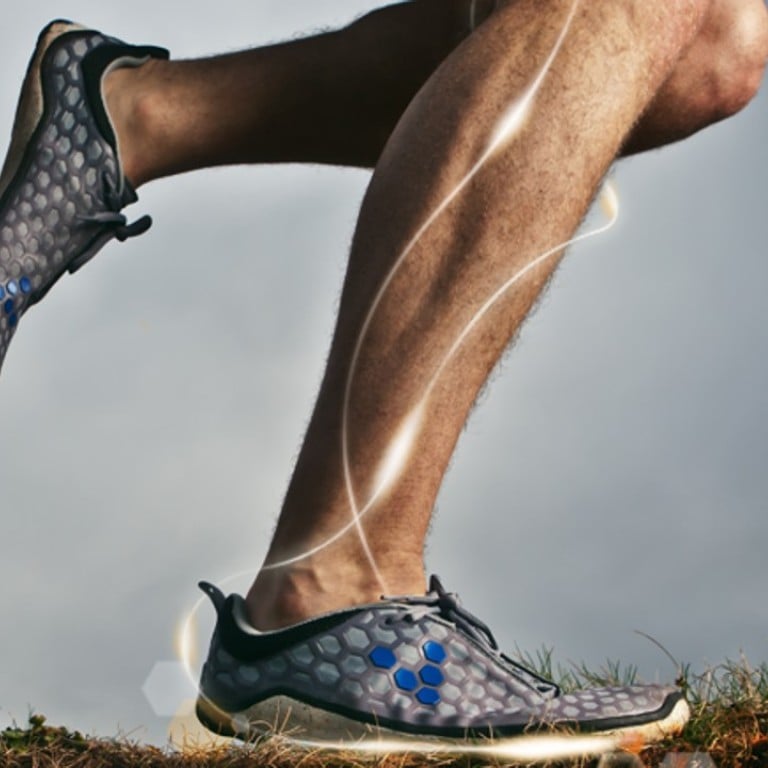
Smartwear: ‘switched on’ shoes and clothes that talk to us
We can all stay connected thanks to running shoes that offer real-time data via mobile apps and underwear with conductive threads that track our vital signs
How smart can a piece of clothing be?
We’ve got running shoes so switched on that they can communicate with you.
Under Armour’s new third-generation, Bluetooth-enabled sneakers, built on its Hovr platform, and the artificially intelligent Vivobarefoot, powered by Sensoria, are coming online this year.
The two brands have distinctly different takes on shock absorbance.
Under Armour employs a propriety foam compound made in partnership with Dow Chemical to help runners absorb the impact on their joints from every stride, while Vivobarefoot – which will reportedly provide real-time monitoring of the wearer’s speed, pace, cadence, GPS track, foot landing technique and ground time, via a mobile app or web dashboard – believes in the foot’s natural ability to manage and interpret its contact with the ground.
However, both are promising new shoes with smart technology to translate data on your physical movement to your mobile device in real time.
We’ve got underwear that tracks our vital signs ... à la Myant SKIIN, which this year will be available with wireless charging. And, there’s more. According to Myant founder and CEO Tony Chahine, one’s smalls will soon be connecting with one’s smart home hub.
“By simply wearing SKIIN garments, your Nest thermostat will adjust to your temperature, your Philips Hue lights will change according to your mood, your smart lock will unlock according to your unique biometric signature, or a calming Spotify playlist will come on when you’re stressed,” Chahine said.
“These are just a few of the ways that SKIIN can interact with the devices that you already have in your home.”
In launching SKIIN, Chahine described textiles as the bidirectional connection between our bodies and the world around us.
“Like a second skin, this new textile computing platform can read, record, analyse and respond to our needs,” he said.
Why is it so?
You should be able to weave [a] textile which can recognise a variety of simple touch gestures, just like any touchpad on a mobile phone
At the Wearable Technology Summit at CES in Las Vegas in January, Dr Ivan Poupyrev,director of engineering at Google, said that the structure of textiles is the same as the structure of touchscreens on mobile devices.
“This means that if you just replace some of the threads in textiles with conductive threads, you should be able to weave [a] textile which can recognise a variety of simple touch gestures, just like any touchpad on a mobile phone,” he said.
“So if you can hide or weave interactivity and input devices into materials, that will be the first step into making computers and computing invisibly integrated into objects such as clothing.”
The Commuter Trucker Jacket with Jacquard, which Google developed with jeans brand Levi’s, is the first example of this type of technology.
Launched online last October, it lets wearers access their music, and navigation, receive texts and make calls via a snap tag attached to the jacket’s cuff.
Dr Ichiro Amimori, CEO and co-founder of, Xenoma, a Japanese start-up, explained his concept for connecting people to the internet via a smart shirt called e-skin.
Xenoma has developed the Printed Circuit Fabric (PCF) technology that makes this possible.
Consumers want real-time information, he said, but conventional wearables can be uncomfortable and cumbersome for the user.
The e-skin connects all devices into one stretchable piece of apparel that is comfortable to wear, washable, and able to withstand the rigours of extreme body motion.
“With e-skin you can improve your form in a variety of sports and activities, control a game character using your whole body, and unobtrusively monitor the safety of infants and the elderly,” he said.
“The time is now when people can interact with each other any time, anywhere, though the internet and their e-skin apparel.”
Also showcased was the Teslasuit, a full-body haptic suit geared to immerse gamers deeper into virtual reality.
We see potential future use [of the Teslasuit] in sectors including manufacturing, automotive, health care and medical fields, in particular for use in rehabilitation
The idea is that, through electrostimulation, players will be able to touch the objects they encounter, and feel sensations such as temperature changes in the virtual environment.
“We wanted the Teslasuit to erase the difference between the virtual and the real worlds,” said Dimitri Mikhalchuk, CEO of Teslasuit Project.
The gaming and entertainment markets are “the natural application for this technology”, Mikhalchuk said.
Yet he foresees that, “as this is smart clothing, it will work well for day-to-day life and well-being, for example, in sports training and fitness.
“But we also see its potential future use in a variety of different sectors including manufacturing, automotive, health care and medical fields, in particular for use in rehabilitation, biometric data set building, collection and data management.”
While such smart garments might not be the prettiest in the wardrobe, fashion brands have started to pick up on the technologies they employ.
Biotechnologies are particularly prime for brands with a sustainability agenda.
Examples include Ferragamo’s partnership with a small Italian start-up to recycle waste from the orange juice industry. The result is a beautiful textile made from citrus peel that feels like silk, and was a sell-out for the brand’s initial Orange Fiber collection.
Another company, BIONIC, now co-owned by performer Pharrell Williams, transforms recycled ocean plastic into fabric.
It began by selling denim jeans under the G-Star RAW label, and last year, a key piece in H&M’s Conscious Exclusive Collection was an evening wear gown of flowing pleats, made from BIONIC.
A fishnet bag made entirely from shoreline waste, as well as elegant earrings made from recycled glass and plastic, also featured in the collection.
“Some amazing technologies not quite to scale yet are happening in early start-ups and laboratories,” said Dr Amanda Parkes, chief innovation officer at Future Tech Lab, a hybrid investment fund, agency and experimental lab focused on the future of sustainable and interactive fashion combining smart textiles, wearable tech and nanotechnology.
“Part of what we need to do to showcase these products is to show the fashion industry – traditionally a bit allergic [to innovation] – what’s been going on with tech and wearables.”



